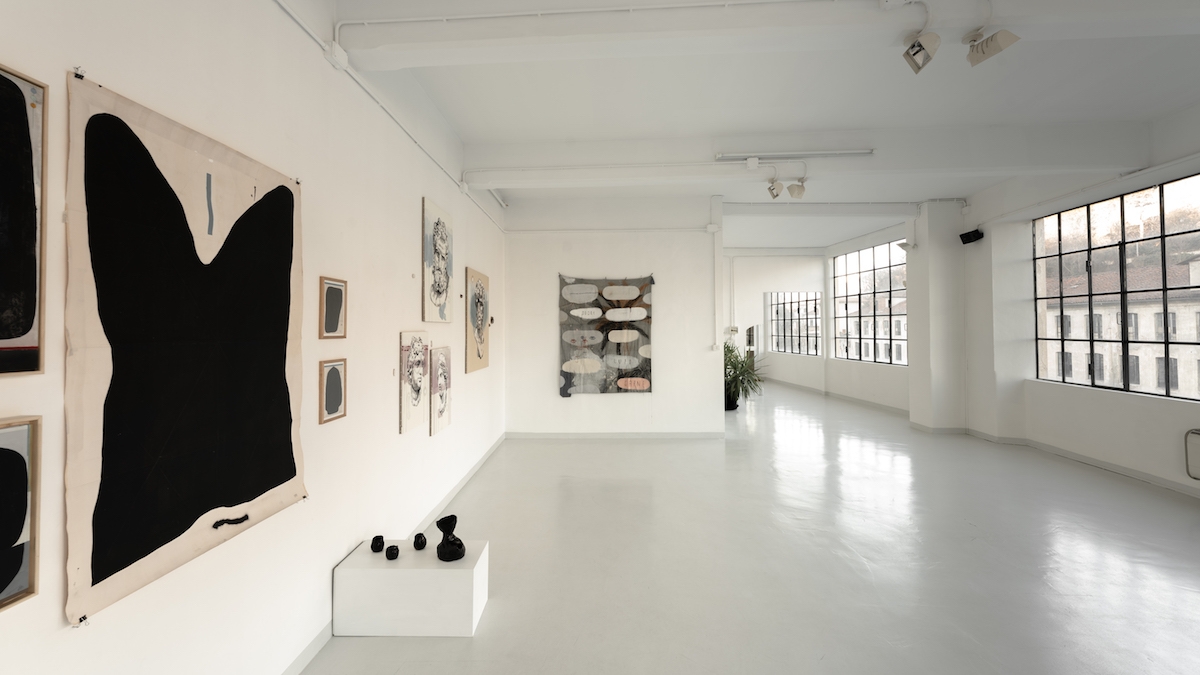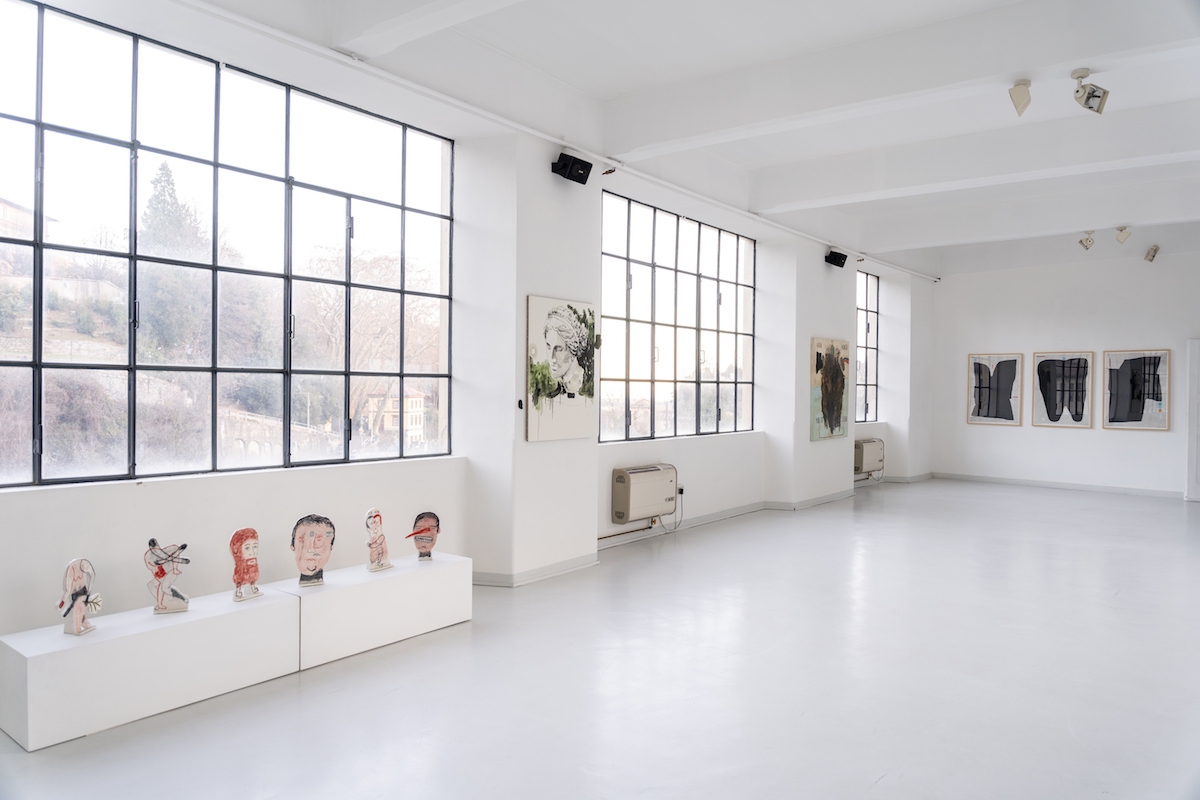CHAOS. THE BALANCE OF PAINTING
by Vera Canevazzi and Caterina Frulloni
In Greek mythology Chaos is a spatial and material entity at once; it is the personification of emptiness, of nothingness; it is the precondition to the whole, to creation and thus to order, as the poet Hesiod wrote. Chaos is an abyss, which determines the constant danger of falling into a primal dimension of formless, dark haziness. So how to defend ourselves? Where to find a shield to protect us from the prevailing confusion of the world?
It is to the practice of painting that a saving mission is due: an exit from blackness, an ever new attempt to shape and manifest a small world. The artist is a demiurge who faces the same catabasis each time: he crosses the darkness of the abyss to return to the light, to the forms and colors of the canvas; he "crosses a catastrophe or an illumination, and leaves on the canvas the trace of this passage, this leap that takes him from chaos to composition," as we read in the text by Félix Guattari and Gilles Deleuze, What is philosophy?
In the artwork, the agitation is tamed and, unpredictably composed, it mellows on the canvas to form a chaosmos, a symbiotic union of order and chaos, inseparable from each other. The result is an ever new harmony, dictated by the inevitable passage of that imponderable ray of chaos that allows us to recognize in works of art the unexpected, the extraordinary. The contemplation of emptiness is then a necessary moment as much for the artist, who must bring new forms into existence, as for the observer, who in a world where the primacy of the image prevails must be able not to see, but to look, with the childlike naiveté of one who observes each work as a microcosm unto itself.
It is from these premises that three dissimilar figurative outcomes are illustrated within the exhibition, three different poetics that come to terms with chaos in alternative and complementary ways. What ensues is a particular dialogue that reflects together on the obscure, ever elusive genesis of the creative process and the necessary rationalization that leads each of the three artists to the expression of their individuality.
Brought together by a past in the 1990s underground scene in their hometown, between skateboarding, graffiti and punk rock, Guido Bisagni aka 108, Matteo Giuntini and Antonio De Luca possess special creative affinities and an inescapable need to connect artistic practice with music, which becomes a medium, sometimes an inspirational muse of content.
The works of 108 (Alexandria, 1978) retains the flavor of graffiti art and historical avant-gardes to push beyond, toward a deeper, unexplored dimension that eludes the forms and laws of Euclidean geometry. Black, primordial chasms are tamed into aniconic forms, thresholds through which the painter is able to glimpse the abyss, and from it, laboriously return. The material he brings to the stage is hybrid, suspended between time and space, synonymous with an inexplicable tension to which only art can strive. The soft, unexpected forms of those dark portals testify to the troubled path of their genesis, the afterthought, then the impulsive detour of the creative process and the artist's intimate connection with it.
In the works on display, from the Stones of Life to the series of Oropa, the use of color is kept to a minimum: the irrational depth of black invades the papers to try to tell the story of a place where mystical cults are intertwined with Christian mysteries, and the dark elements in the works allude now to the black virgin of Oropa, now to the miraculous stones of her shrine. 108's attention to the spiritual dimension of art blends with his interest in anthropology and the philosophies of religions, where the mythical dimension blends with the cultural and spiritual bearing of humanity.
Matteo Giuntini (Livorno, 1977) paints a parallel reality of ironic allusion, where a chaotic postponement of meanings attests to the plausibility of an implausible world.
His surrealist universe combines allegories and symbols that often dictate peculiar semantics, where images interact on the original meaning of words to give rise to a dynamic narrative. Writings such as Agave, Flower o Garlic thus suggest misleading readings, prompting the viewer to set in motion an interpretive process. While the author suggests a narrative, he also conceals it: working by layering and erasure he thus leaves traces of his own creative process.
Yet, in the figurative worlds that Giuntini traces to the rhythm of music, one cannot ignore the artist's estrangement or shy away from respecting the rules of the game he dictates. The world appears under another gaze, more democratic and free, populated by hybridized characters who inhabit the canvases without hierarchies with plants and strange animals. It is a kind of veracious and powerful saturnalia, where one feels one is touching the artist's intimacy and at the same time regaining purity and sincerity as one loses oneself in his human and vegetable thickets. Even the viewer must admit the chaos in order to participate in the creative challenge that Giuntini establishes, for to juggle his labyrinth one must never abandon active enjoyment and reflection.
Antonio De Luca (Pompeii, 1977) relentlessly seeks a formal balance that from the figures of nature accompanies him to the vision of perfect beauty.
Delicate creatures in watercolors and oils, suspended between the dreamlike world and Orientalism accompany the viewer to an ethereal and supersensible dimension, far from the chaotic upheavals and ugliness of reality. The figures, almost evanescent, are barely outlined through quick pictorial strokes that traverse empty and neutral backdrops, devoid of characterization and for this reason all the more distant from the disorienting fullness of the everyday.
The series of the Sculptures on paper, juxtaposed by the artist in the exhibition with his ethereal figures, once again reveal the tension toward the attainment of absolute harmony, choosing as subjects precisely the ancient statues that classical aesthetics counted as the formally faultless products of art history.
Harmony and perfection that do not, however, remain enclosed within a composition, whose limits are marked by the area of the canvas or sheet, but extend into the surrounding space through small ceramic extensions that connect the work to the environmental context. Thus the intangible figures cautiously enter the viewer's world, allowing the world of imagination and the world of reality to unite and merge.



